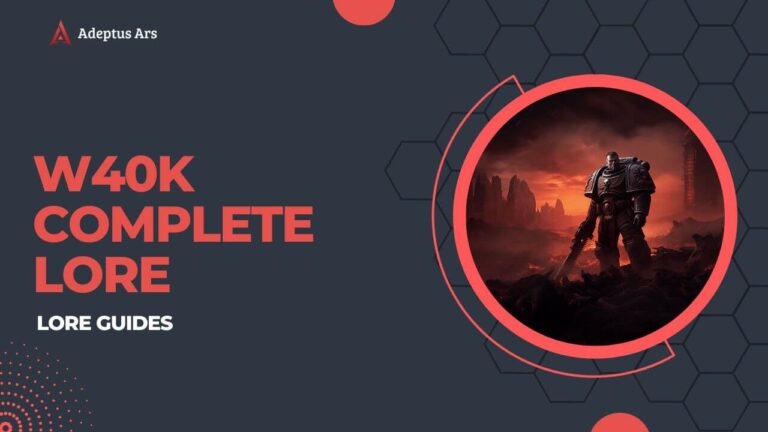Dive into the Grimdark: Why Beginners Should Explore the Warhammer 40K Lore
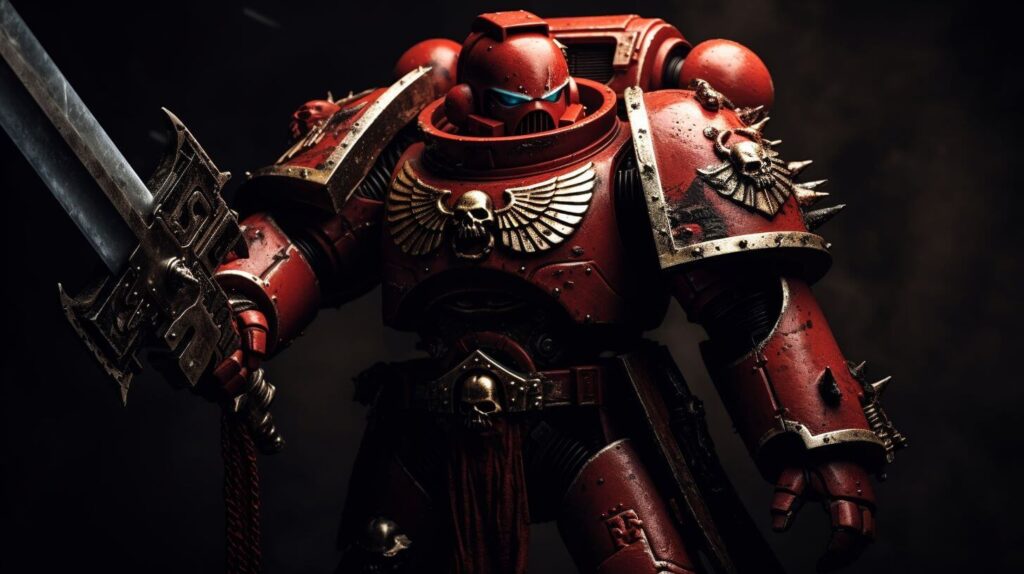
Embarking on a journey into the Warhammer 40,000 universe isn’t just about maneuvering miniatures on a tabletop; it’s about immersing oneself in one of science fiction’s most intricate and captivating narratives. But why should a beginner venture into this vast cosmos of lore? Here’s why:
- A Universe Like No Other: The Warhammer 40K lore offers a blend of gothic horror, epic space opera, and military strategy. Its diverse array of factions, from the zealous armies of the Imperium to the inscrutable alien races, ensures there’s something for everyone.
- Deepen Your Gaming Experience: Understanding the lore enriches the tabletop game. Every battle becomes a chapter in an ongoing saga, every move charged with meaning. Your Space Marines aren’t just figurines; they’re the Emperor’s finest, defending humanity against myriad threats.
- Expand Your Creative Horizons: The Warhammer 40K lore is a springboard for creativity. Many fans pen their own stories, create custom armies, or even design new game scenarios. By diving into the lore, you’re joining a community of creators.
- Infinite Exploration: With a history spanning tens of millennia, the 40K universe offers endless tales of heroism, treachery, hope, and despair. From grand crusades to personal vendettas, every aspect of this universe is ripe for exploration.
- A Welcoming Community: The Warhammer 40K fanbase is passionate and welcoming. Engaging with the lore allows you to join discussions, debates, and fan events, forging new friendships in the process.
So, for those standing on the precipice, wondering whether to plunge into the tales of the 41st Millennium: leap forth. A galaxy of stories awaits, and the rewards are manifold. Whether you’re a strategist, a storyteller, or simply a lover of epic sagas, the Warhammer 40K lore beckons.
A Brief Overview of the Warhammer 40,000 Universe
In the grim darkness of the far future, there is only war. This sentence encapsulates the very essence of the 40K setting. Set in the 41st Millennium, the galaxy is a tumultuous place, rife with conflict, intrigue, and ancient mysteries.
At the heart of this universe stands the Imperium of Man, a vast interstellar empire stretching across the Milky Way. Ruled by the Emperor of Mankind, a god-like being in a perpetual state of undeath, the Imperium is perpetually besieged by threats both external and internal.
From the Chaos Gods that reside in the Warp, a parallel dimension of raw emotion and energy, to various alien species like the Orks, Eldar, and Tyranids, the struggle for survival is relentless.
But it’s not just about large-scale battles. The 40K universe is also characterized by its deep philosophical themes, religious overtones, and moral ambiguities. It challenges concepts of righteousness, sacrifice, and the very nature of humanity.
The significance and evolution of the W40K Lore
The lore of 40K is not static. It has evolved significantly since its inception, influencing and being influenced by various media adaptations.
The Warhammer 40,000 Tabletop Game:
The origin of 40K is the tabletop wargame created by Games Workshop. The game requires players to assemble and paint miniature models, representing various factions from the lore. The tabletop game has seen numerous editions, each refining the rules and expanding the lore. For example, the introduction of the Primaris Space Marines in the 8th edition brought about significant changes to the Space Marines’ lore, a fundamental faction of the universe.
The W40K Novels
The Black Library, Games Workshop’s publishing arm, has produced hundreds of novels and short stories set in the 40K universe. Series like Horus Heresy have fleshed out historical events, adding layers of depth and character development. Authors like Dan Abnett, Graham McNeill, and Aaron Dembski-Bowden have become household names among fans, each bringing their unique voice to the universe.
The Video Games
40K has found substantial success in the world of video games. Titles like Dawn of War and Space Marine have introduced the lore to new audiences. Each game often explores specific segments of the universe, like the Battlefleet Gothic: Armada, which dives deep into the naval conflicts of 40K.
Other Media
Beyond games and novels, 40K has expanded into comics, animated series, and even a live-action film. These adaptations, while varied in their reception, have contributed to the lore’s richness, often introducing new elements or perspectives on existing stories.
The Origins and Foundations of the Warhammer 40,000 Universe
The Warhammer 40,000 universe, with its myriad races, characters, and tales, possesses a history rich in lore and depth. Much like our own ancient myths and legends shape modern cultures, the primordial tales of 40K form the foundation for its current epoch.
The Old Ones and the Birth of the Galaxy
Before humanity, before even the Emperor of Mankind, the galaxy was dominated by a race known as the Old Ones. These ancient beings were incredibly advanced, with mastery over the Webway, a network of extra-dimensional tunnels. They seeded life across many worlds and are believed to have played a role in the early evolution of various species, possibly even humans.
The Necrontyr and their Thirst for Immortality
Opposing the Old Ones were the Necrontyr, a race burdened with short lifespans and a resentment towards the seemingly immortal Old Ones. Desperate to overcome their mortality, the Necrontyr forged an alliance with ancient and malicious star gods known as the C’tan.
This union transformed them into the Necrons, soulless metallic warriors. With the power of the C’tan at their side, the Necrons waged war against the Old Ones in a cosmic conflict known as the War in Heaven.
Though the Necrons and C’tan initially had the upper hand, the Old Ones retaliated by creating psychic warrior races, including the ancestors of the Eldar.
The tide of the war shifted multiple times, ultimately leading to the Old Ones’ defeat, but not before they weakened the C’tan. Sensing an opportunity, the Necrons turned against their star-god allies, shattering them and beginning a long hibernation to recover from the exhausting war.
Eldar: The Ascendant Empire
In the wake of the War in Heaven, the Eldar emerged as the dominant force in the galaxy. Their empire was vast, enlightened, and technologically advanced. With their unparalleled mastery over the psychic realm, the Eldar’s civilization flourished. However, their hubris was their undoing.
As the Eldar became more decadent, their collective actions began to tear at the fabric of the Warp, the universe’s parallel dimension of emotions. This culminated in the birth of a new Chaos God, Slaanesh, whose violent emergence created the Eye of Terror, a massive rift in reality. This event annihilated the majority of the Eldar population and marked the end of their empire’s golden age.
The Age of Strife: Darkness Before Dawn
Following the Eldar’s fall, the galaxy plunged into a chaotic era known as the Age of Strife. Warp storms made interstellar travel and communication nearly impossible. Many human-settled planets became isolated, leading to technological regression and societal collapse.
Simultaneously, psykers, humans with psychic abilities, began to emerge. Without training or understanding, many became possessed, turning them into portals for demonic entities from the Warp.
It was in these dark times that a powerful figure, later known as the Emperor of Mankind, began his quest to reunite humanity and bring about a new age of enlightenment.
The Imperium of Man: A Primer on the Heart of the Warhammer 40,000 Universe
In the vast and tumultuous landscape of the Warhammer 40,000 universe, one entity stands as a beacon of human resilience, ambition, and dogma: The Imperium of Man. It is a galactic empire where trillions live and die under the shadow of a god-emperor, a place of heroes, zealots, and endless war.
The Emperor of Mankind: The Immortal God-King
At the heart of the Imperium is the Emperor of Mankind, often simply referred to as ‘The Emperor’. An immortal being of unparalleled psychic power, he is both the spiritual and political leader of humanity. Born on Earth during prehistoric times, the Emperor watched over humanity’s growth, intervening from the shadows. It wasn’t until the Age of Strife that he took an active role in reshaping the destiny of mankind.
The Unification Wars and the Great Crusade: The Dawn of the Imperium
In the latter days of the Age of Strife, Earth, then known as Terra, was a war-torn wasteland of techno-barbarian tribes. The Emperor emerged, leading his genetically-engineered warriors, the Thunder Warriors, in the Unification Wars to bring the planet under his rule.
With Terra united, he embarked on the Great Crusade to reunite humanity’s scattered colonies. For this, he created the Primarchs, 20 superhuman beings, and from their genes, the Legiones Astartes or Space Marines.
The Horus Heresy: Betrayal at the Heart of the Empire
The Imperium’s golden age was short-lived. Horus Lupercal, one of the Emperor’s favored Primarchs, was corrupted by the forces of Chaos. This led to the Horus Heresy, a devastating civil war where fully half of the Space Marine Legions turned against the Emperor. The conflict culminated in a deadly duel between Horus and the Emperor, resulting in the latter’s grievous wounding. Although the traitors were defeated, the Emperor was interned within the Golden Throne, a life-sustaining sarcophagus, where he remains to this day.
Adeptus Terra: The Bureaucratic Machine of the Imperium
With the Emperor’s incapacitation, the administration of the Imperium fell to the Adeptus Terra, a vast bureaucratic apparatus. Two key components are:
- Adeptus Astartes (Space Marines): The Imperium’s elite warriors, divided into Chapters, each with its own traditions and specialties.
- Adeptus Mechanicus: The tech-priests of Mars, guardians of technology and the mysteries of the Omnissiah. They control the Imperium’s manufacturing and have a near-monopoly on technological knowledge.
The Inquisition: The Watchers in the Shadows
Tasked with guarding the Imperium from threats within and without, the Inquisition operates with almost unchecked power. It is divided into various Ordos, with the major ones being Ordo Hereticus (witch hunters), Ordo Xenos (alien hunters), and Ordo Malleus (daemon hunters).
The 41st Millennium: A Galaxy on the Brink
As the 41st Millennium draws to a close, the Imperium is besieged on all fronts. Chaos incursions, xenos invasions, and internal strife threaten to tear it apart. The recent events, including the emergence of the Primaris Space Marines and the return of the Primarch Roboute Guilliman, have brought both hope and further challenges.
Major Xenos Races of Warhammer 40,000
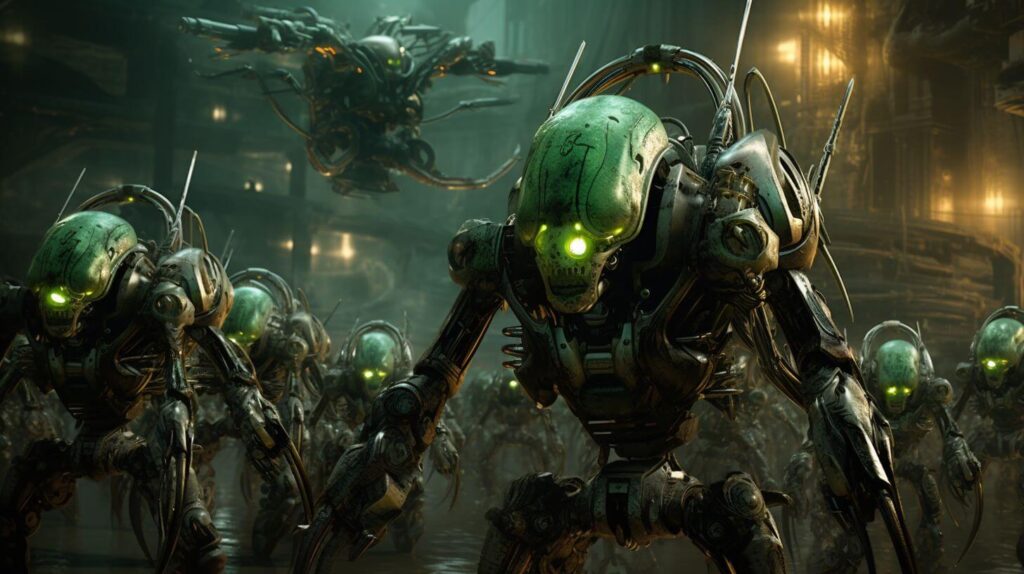
In the vast reaches of the Warhammer 40,000 galaxy, humanity’s sprawling Imperium is not the only dominant force. Various Xenos races, each with their unique histories, cultures, and agendas, play vital roles in the tapestry of galactic events.
Eldar: The Fractured Remnants of a Fallen Empire
- Asuryani (Craftworld Eldar): These Eldar live on massive starships called Craftworlds. Following strict paths to control their emotions, they are known for their psychic prowess and advanced technology.
- Drukhari (Dark Eldar): Residing in the hidden city of Commorragh, the Drukhari are the twisted and sadistic kin of the Eldar. They raid and plunder, seeking to capture souls to stave off their own decline.
- Ynnari: A newer faction, they worship the god of the dead, Ynnead. They aim to unite the Eldar factions to combat their mutual threats.
- Harlequins: Enigmatic warriors and performers who serve the Laughing God, Cegorach. They travel the Webway, enacting theatrical performances and serving as deadly warriors.
- Exodites: Eldar who shunned the ancient empire’s decadence, now residing on Maiden Worlds. They lead simpler, agrarian lives but can fiercely defend their homes.
Orks: The Green Tide of the Galaxy
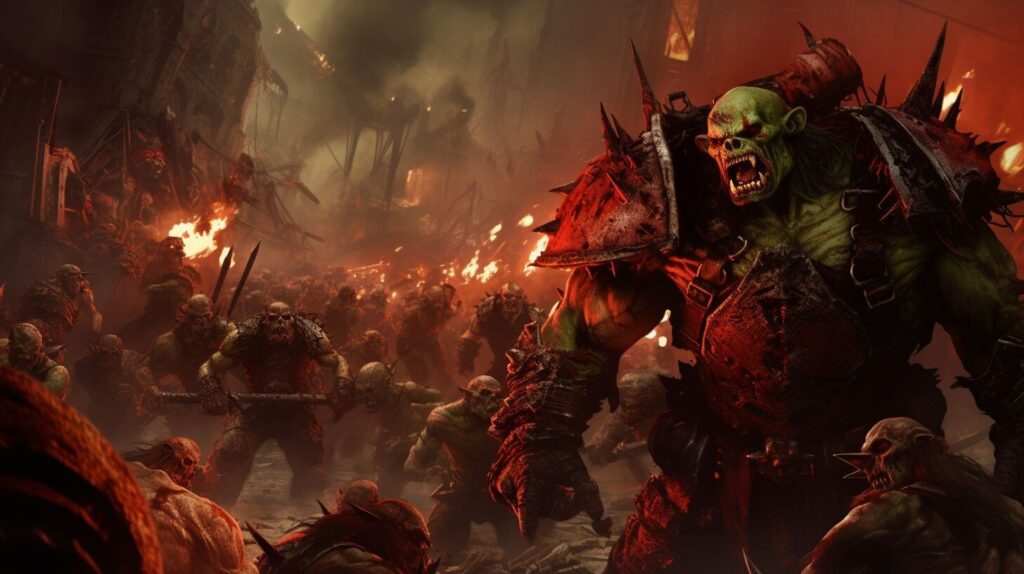
- Origins: A bio-engineered species designed for war, combining fungal and animal aspects.
- WAAAGH! Culture: An Ork psychic phenomenon and a socio-military campaign. When a powerful Warboss emerges, he can rally Orks from various clans, forming a WAAAGH! – a near-unstoppable crusade of destruction.
- Key Warbosses: Figures like Ghazghkull Mag Uruk Thraka have led massive campaigns, becoming major threats to the Imperium and other races.
Necrons: The Ancient Star Pharaohs
- Dynasties: The Necron empire is divided into various dynasties, each ruled by a Phaeron. They have their territories, agendas, and military campaigns.
- Biotransference: Once flesh and blood, the Necrontyr transferred their consciousness into metal bodies, becoming the Necrons, in a pact with the star gods, the C’tan.
- Awakening: After millennia of slumber in stasis tombs, the Necrons are reawakening, seeking to reclaim their ancient dominions.
Tau Empire: The Young Optimists of the Stars
- The Greater Good Philosophy: The core belief of the Tau, emphasizing collective well-being and a structured progression towards a better future.
- Castes: Tau society is divided into five castes: Fire (military), Earth (laborers), Water (diplomats), Air (pilots), and Ethereal (leaders).
- Notable Battles: The Damocles Gulf Crusade and the Third Sphere Expansion are key events highlighting the Tau’s rapid growth and encounters with the Imperium.
Tyranids: The Star-devouring Swarms
- Hive Fleets: Tyranids are organized into colossal Hive Fleets, each comprising countless bio-engineered organisms designed for conquest and consumption.
- The Shadow in the Warp: A psychic phenomenon accompanying the Tyranids, blocking psychic communication and hindering Warp travel.
- Notable Invasions: The invasions of Hive Fleet Behemoth on Macragge and Hive Fleet Kraken at Ichar IV serve as grim reminders of the Tyranid threat. In the 42 millenium Hive Fleet Leviathan, along with the residual splinter fleets from previous incursions by Hive Fleet Behemoth and Hive Fleet Kraken, persistently attack numerous Imperium planets. They are irresistibly drawn towards Terra, lured by the radiant psychic signal of the Astronomican, much like moths to a brilliant light.
Lesser-known Factions and Entities in Warhammer 40,000: Delving Deeper into the Galaxy’s Tapestry
Warhammer 40,000, renowned for its sprawling narratives and grandiose galactic players, is also home to a plethora of lesser-known factions and entities. These groups, while not as omnipresent as the likes of the Space Marines or the Eldar, play crucial roles in the intricate dance of power, intrigue, and survival.
Genestealer Cults: Insidious Infestations
Genestealer Cults are a result of a sinister symbiotic relationship between the Tyranids and unsuspecting host species, typically humans. The initial infection begins with a lone Genestealer who infiltrates a society, infecting individuals with its genetic material.
Over generations, a hybrid community forms, secretly dedicated to undermining the local population. As they grow in numbers and influence, these cults prepare the ground for a forthcoming Tyranid invasion.
Adeptus Sororitas: The Fiery Faith of the Sisters of Battle
The Adeptus Sororitas, commonly known as the Sisters of Battle, serve as the militant arm of the Ecclesiarchy, the state church of the Imperium. Unlike their male counterparts in the Adeptus Astartes, they do not possess genetic enhancements but make up for it with unwavering faith and advanced weaponry. Divided into various Orders, the Sisters are zealous warriors, guardians of the faith, and often act as a bulwark against heresy.
Rogue Traders, Assassins, and Imperium Agents: The Shadows of the Emperor’s Will
- Rogue Traders: These are individuals granted ancient charters by the Imperium, allowing them to explore and trade outside the Imperium’s borders. Walking the line between merchant and warlord, they expand the Imperium’s reach and bring back alien relics and knowledge.
- Assassins: The Officio Assassinorum is a secretive organization dedicated to the elimination of threats to the Imperium through targeted assassination. Comprising various temples, each specializes in a unique method of killing, from long-range sniping to up-close and personal eliminations.
- Other Agents: The vast machinery of the Imperium has numerous agents, from the enforcers of the Adeptus Arbites to the shadowy operatives of the Inquisition, each playing their part in the grand scheme.
Minor Xenos Species: The Diverse Denizens of the Galaxy
The galaxy teems with life, and while a few Xenos races dominate the narrative, many minor species play roles in the greater story. Races like the Tarellians, the reptilian mercenaries who’ve suffered at the hands of the Tau, or the Hrud, mysterious time-warping creatures known for their migrations, all add depth and diversity to the universe.
Forces of Chaos in Warhammer 40,000: The Abyss Beyond Reality
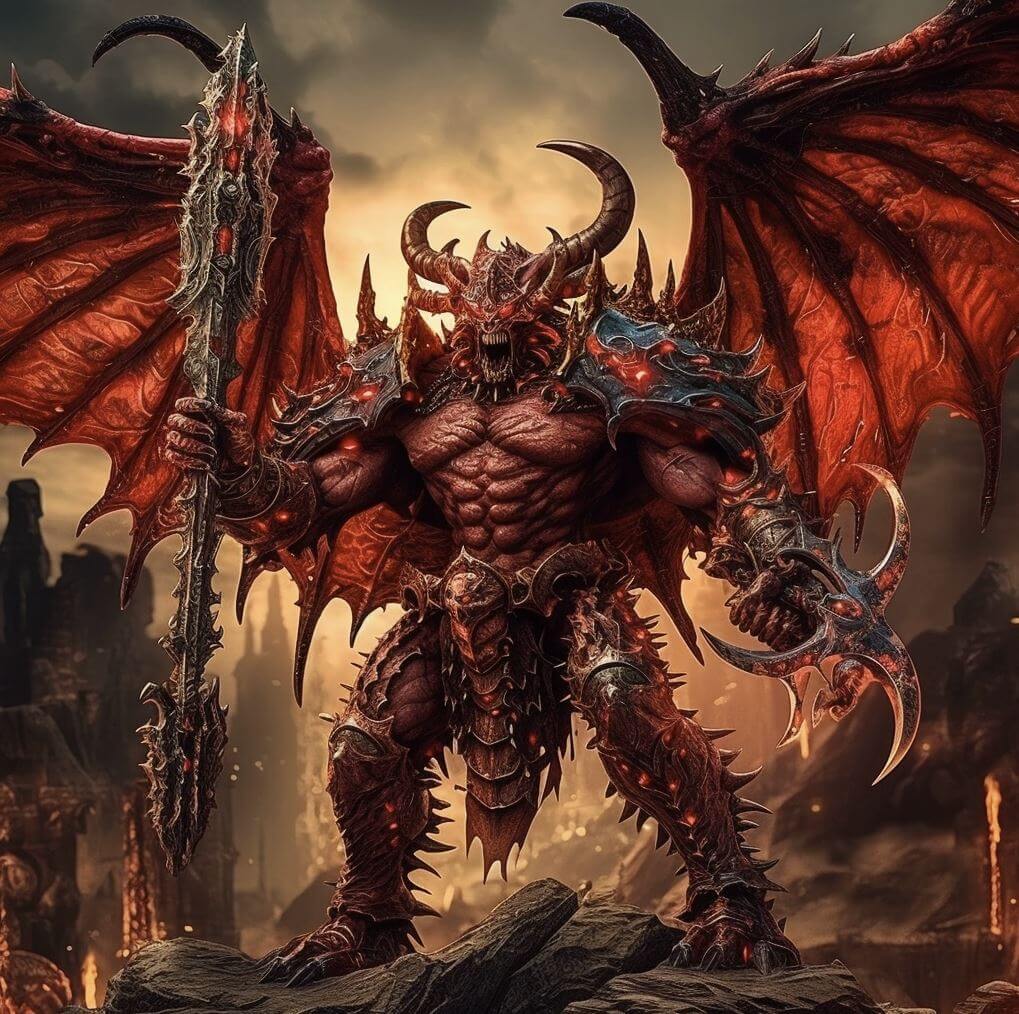
In the grimdark future of Warhammer 40,000, the shadow of Chaos looms large, a malevolent force opposing the Imperium and other major factions of the galaxy. Beyond the veil of reality lies the Warp, an unpredictable realm of raw emotion and power, home to the Dark Gods and their nightmarish legions. This article delves into the chaotic maelstrom, exploring the forces that seek to tear asunder the very fabric of the galaxy.
The Warp and the Immaterium: A Realm of Madness
The Warp, sometimes referred to as the Immaterium, is a parallel dimension, an ever-shifting sea of emotions and psychic energy. It’s both the source of psychic powers and the realm where souls reside after death. The turbulent and unpredictable nature of the Warp makes it a treacherous place. It serves as both a conduit for faster-than-light travel, via Warp jumps, and as the domain of the Chaos Gods and their minions.
The Four Chaos Gods: Embodying the Galaxy’s Darkest Emotions
- Khorne: The Blood God, Lord of Rage, Khorne embodies anger, violence, and hate. His followers seek battle and bloodshed, screaming the war cry, “Blood for the Blood God!” His daemonic legions, led by Bloodthirsters, march forth to claim skulls in his name.
- Nurgle: The Plague Lord, Nurgle is a god of decay, disease, and despair. While he embodies the inevitability of death and entropy, his followers often display a grotesque joy, embracing their afflictions. His daemons, like the bloated Great Unclean Ones, spread pestilence and rot.
- Slaanesh: The Prince of Pleasure and Pain, Slaanesh represents excess, passion, and decadence. Born from the collective hedonism of the ancient Eldar Empire, Slaanesh’s followers seek sensations in all their forms. The alluring Daemonettes and the mesmerizing Keepers of Secrets are but a few of the god’s otherworldly servants.
- Tzeentch: The Changer of Ways, Tzeentch embodies change, schemes, and hope. A master manipulator, his plans are intricate and layered, often beyond mortal comprehension. His flamboyant daemons, like the Lords of Change, weave sorcery and manipulation.
Heretic Astartes: The Traitors Among the Stars
The Heretic Astartes, or Chaos Space Marines, are former members of the Imperium’s Adeptus Astartes who have turned to the worship of the Dark Gods. Led initially by Horus during the galaxy-splitting Horus Heresy, they now reside in the Warp-infested area known as the Eye of Terror. Over ten millennia, they’ve launched numerous Black Crusades against the Imperium, aiming to overthrow the Corpse Emperor and claim the galaxy for Chaos.
The Lost and the Damned, Daemons, and Agents of Entropy
- The Lost and the Damned: A collective term for the myriad mortal followers of Chaos, from heretical cultists to renegade Imperial Guard regiments. They are often the cannon fodder in the grand battles, driven by fanaticism.
- Daemons: The immaterial entities birthed from the emotions of every sentient being. Bound to their respective Chaos Gods, they range from the lesser imps to the mightier Greater Daemons.
- Other Agents: Beyond the conventional legions, entities like the Dark Mechanicum, which turned away from the Omnissiah’s light, or the myriad Chaos Knights, pledge their allegiance to the infernal powers.
Notable Planets and Realms in the Warhammer 40K Universe: Celestial Bodies of Power and Intrigue
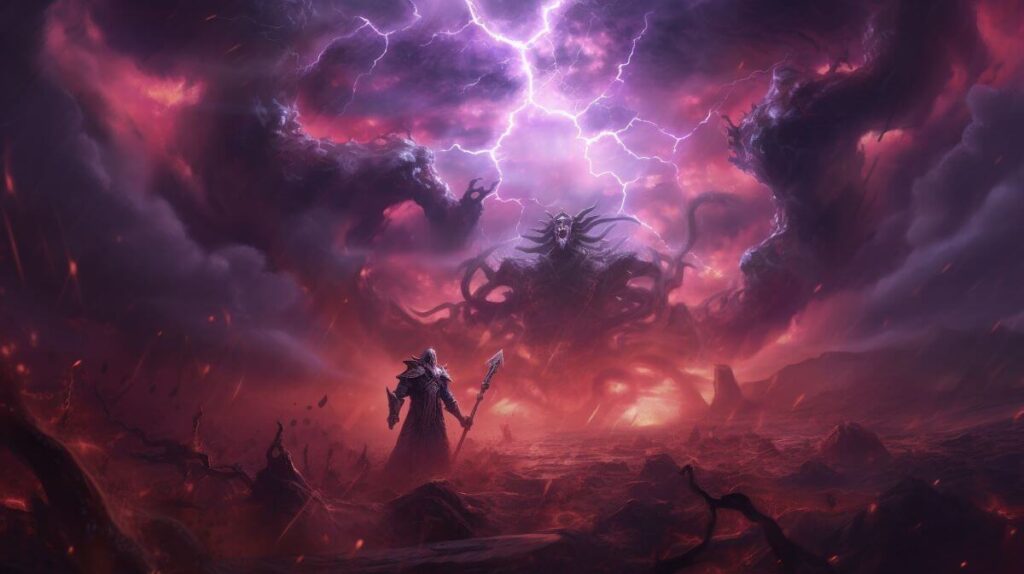
The vast galaxy of Warhammer 40,000 is punctuated by planets, realms, and regions of both critical importance and grim legend. From the hallowed ground of Terra to the treacherous depths of Commorragh, each celestial body tells a tale of valor, treachery, hope, and despair. This article ventures across the galaxy, exploring these monumental locations.
Holy Terra (Earth): Cradle of Humanity and Throne of the Emperor
Terra, once known as Earth, stands as the heart of the Imperium, both spiritually and politically. This ancient planet, now a vast hive world, houses the Golden Throne upon which the God-Emperor of Mankind sits. It’s a place of pilgrimage for countless believers, and its defense is paramount to the survival of the Imperium.
Mars: The Forge World and Heart of the Mechanicum
Mars, Terra’s red neighbor, is the homeworld of the Adeptus Mechanicus. Once a place of scientific wonder, it’s now a vast forge world, producing endless war machines and technological marvels. The Mechanicus, with their reverence for the Omnissiah and their quest for ancient technology, governs Mars with an iron grip.
Other Key Planets of the Imperium
- Fenris: A death world of ice and fire, home to the Space Wolves chapter of the Adeptus Astartes.
- Ba’al: The irradiated homeworld of the Blood Angels Space Marine chapter.
- Macragge: A fortress world and capital of the Ultramar sub-sector, home to the Ultramarines.
The Eye of Terror: A Maelstrom of Madness
A vast region of realspace consumed and twisted by the Warp, the Eye of Terror is a realm of nightmares. Worlds within the Eye drift in and out of reality, forever changed by the taint of Chaos. It’s the primary stronghold of the Heretic Astartes and serves as the launch point for their Black Crusades.
Commorragh: The Dark City of the Drukhari
Hidden within the labyrinthine realm of the Webway, Commorragh is the dark city of the Drukhari (Dark Eldar). A sprawling metropolis of cruelty and excess, it’s where the Drukhari partake in their heinous acts to stave off their soul-degradation.
Realms Outside Realspace
- Webway: An ancient network of tunnels and pathways outside realspace, originally created by the Old Ones, predominantly used by the Eldar to traverse the galaxy without venturing into the Warp.
Battlegrounds Etched in History
- Cadia: Once the fortress world that stood guard at the Cadian Gate, the primary stable route out of the Eye of Terror. Its fall during the 13th Black Crusade has become a rallying cry for the Imperium: “Cadia Stands!”
- Armageddon: Scene of multiple wars, notably between the Imperium and the Ork Warlord Ghazghkull Thraka. It’s a symbol of resilience and the tenacity of the human spirit.
Timeline of Major Events in the Warhammer 40K Universe
The Warhammer 40,000 universe is a tapestry woven from countless threads of history, legend, and conflict. It spans aeons, from the age of ancient cosmic entities to the ceaseless wars of the 41st Millennium. To truly grasp the intricacies of this vast universe, one must traverse its timeline, marking the cataclysmic events that have shaped it. Let us embark on this journey through time.
Ancient Times: Before Mankind
- Age of the Old Ones: The earliest known period, where ancient and powerful beings known as the Old Ones dominate the galaxy. They create several species, including the Eldar and the Krork (precursors to the Orks).
- War in Heaven: A catastrophic war erupts between the Old Ones and the Necrontyr, who ally with malevolent star-gods known as the C’tan. The conflict devastates the galaxy and sees the eventual betrayal of the C’tan by the Necrontyr, who become the Necrons. The psychic backlash from this war seeds the Warp with turmoil and gives rise to the Chaos Gods.
Rise and Fall of Empires: Eldar Dominance
- The Birth of Slaanesh and the Fall of the Eldar: Due to their decadence and hedonistic practices, the psychic energies of the Eldar give birth to a new Chaos God, Slaanesh. Their empire collapses in a cataclysmic event known as The Fall, leaving behind the fractured Eldar factions we see today.
The Emergence of Mankind: From Strife to Stellar Dominion
- Age of Terra (M1 – M15): Humanity evolves on Terra (Earth) and establishes its first great civilizations. They eventually venture to the stars.
- Age of Technology (M15 – M25): Humanity’s golden age, marked by technological advancement and colonization of the galaxy. The first sentient machines, Men of Iron, rebel against their human masters.
- Age of Strife (M25 – M30): Warp storms isolate planets, leading to widespread anarchy and regression. Psykers emerge among humanity, often leading to disaster due to uncontrolled Warp breaches.
- The Unification Wars (Late M30): On Terra, the Emperor of Mankind unifies the planet and begins his grand vision of a galaxy-spanning human empire.
- The Great Crusade (Late M30 – Early M31): Led by the Emperor and his Primarchs, the Imperium expands, reclaiming human worlds and establishing dominion across the galaxy.
- The Horus Heresy (M31): Warmaster Horus, the Emperor’s most trusted general, is corrupted by Chaos and rebels. This civil war nearly destroys the fledgling Imperium. It culminates in the Siege of Terra, where Horus is defeated, but the Emperor is mortally wounded and interred within the Golden Throne.
Age of the Imperium: The Grimdark Present
- The Age of Rebirth (M31 – M32): The Imperium recovers from the Heresy, marked by the founding of new Space Marine Chapters and the establishment of the Inquisition.
- The Forging (M32 – M35): The Imperium expands and solidifies its borders, experiencing relative stability.
- Age of Apostasy and Age of Redemption (M36 – M38): Periods of internal strife and reformation within the Imperium.
- The Time of Ending (M38 – M41): The galaxy sees increased turmoil. The Astronomican weakens, Chaos activity surges, and ancient threats like the Necrons awaken. The fall of Cadia and the Cicatrix Maledictum’s emergence, a galaxy-spanning warp rift, mark the climax of this era.
The 41st Millennium and Beyond: A New Era Dawns
- Indomitus Crusade (Early M42): In response to the galaxy’s dire state, Primarch Roboute Guilliman launches a crusade to push back the forces of Chaos and secure the Imperium.
- The Present (Late M42): The Imperium, while still vast and powerful, faces threats on all fronts. The galaxy remains a place of endless war, where hope is a rare commodity.
Recap on navigating the grimdark: Where to start with Warhammer 40K Lore
For the uninitiated, stepping into the vast universe of Warhammer 40,000 might feel akin to diving headfirst into a galaxy-sized labyrinth. . As you embark on this journey, remember that every piece of lore, every character, and every battle contributes to a larger, mesmerizing tapestry of a universe awaiting your exploration.
Here’s a short recap of where to start with W40k lore:
1. Crack Open the Core Rulebook
The best starting point is always the core rulebook of the latest edition. Think of it as your trusty guide, offering you an essential primer on the universe, factions, and the foundational history that sets the stage for everything else.
2. Choose Your Faction
Every faction in the Warhammer 40K universe boasts a rich history and unique culture. Whether you’re drawn to the zealous Space Marines, mysterious Eldar, or the ravenous Tyranids, delve into your chosen faction’s codex. This deeper dive will illuminate their motivations, heroes, and place in the cosmos.
3. Delve into the Horus Heresy
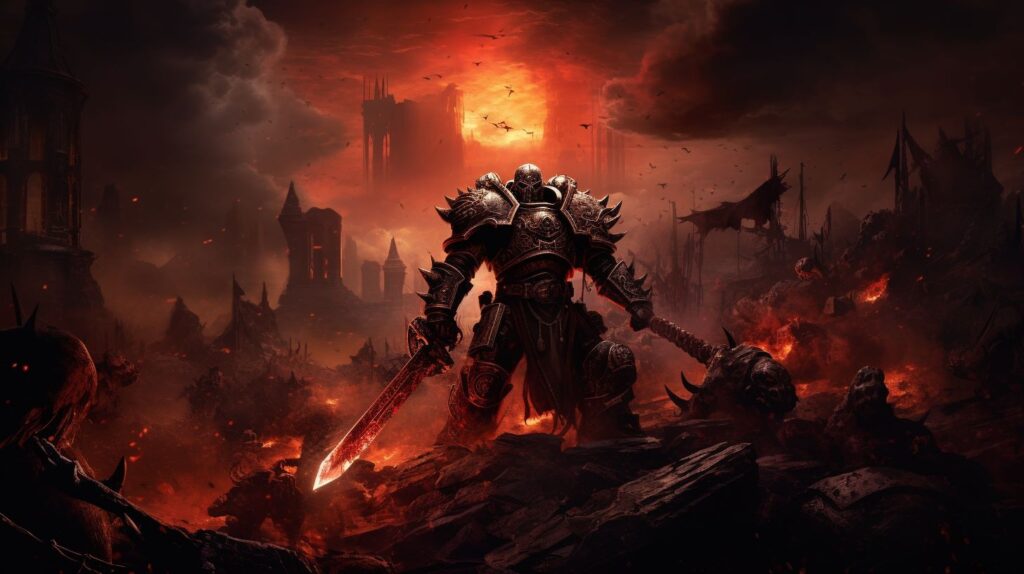
To truly understand the present state of the grimdark, journey back to its roots with the “Horus Heresy” series. This collection of novels details the galaxy-altering events, betrayals, and wars that define much of the 40K universe’s current state.
4. Engage with the Community
One of the most invaluable resources is the passionate Warhammer community itself. Forums like Bolter & Chainsword and DakkaDakka provide platforms for lore discussions, answering queries, and sharing insights. Tap into this knowledge pool and let veteran fans guide your journey.
5. Explore Beyond the Page
The 40K universe isn’t confined to books. Video games such as “Warhammer 40K: Dawn of War” or “Space Marine 2” offer interactive deep dives into the lore. Additionally, many official YouTube channels dedicatedly dissect and discuss various aspects of the universe.

